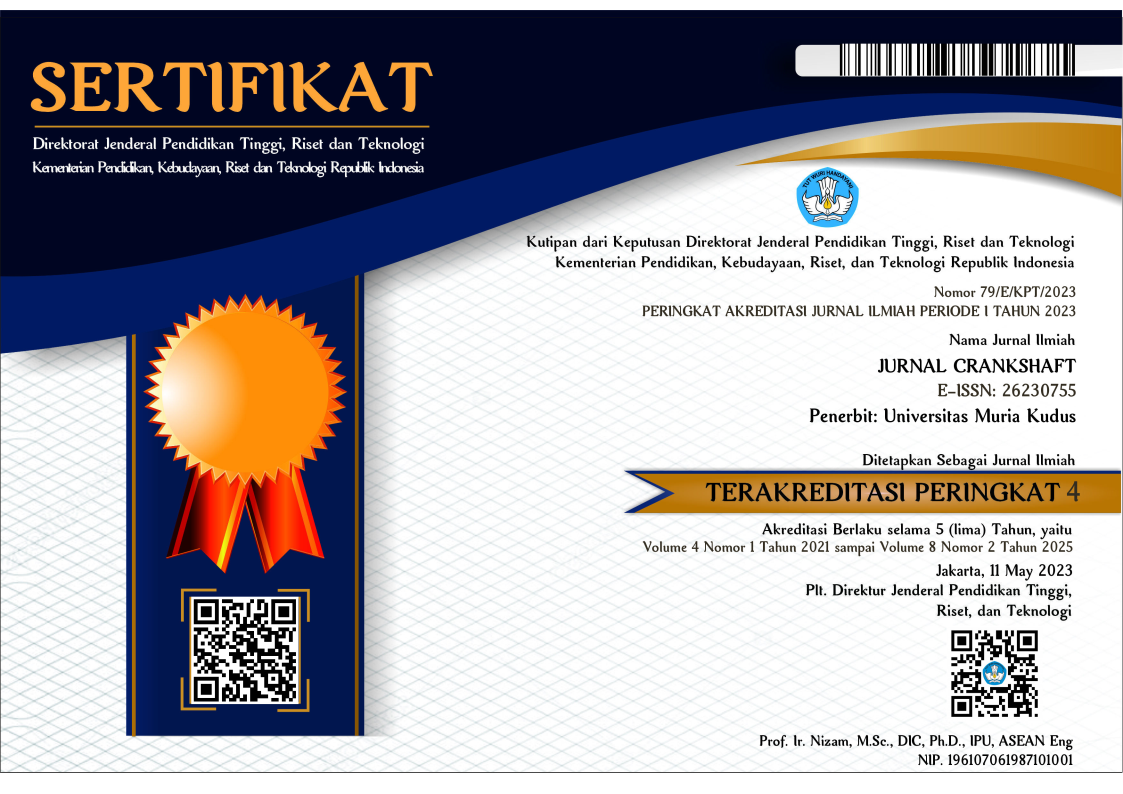Analisis Redaman Sistem Vibrasi Paksa Satu Derajat Kebebasan Pada Simple Vibration Apparatus
Sari
Vibration testing in the field of mechanical engineering has an important role in planning and maintaining machines to determine whether the design is safe and suitable for application. Newton's second law is a reference for back-and-forth movement around equilibrium both within the system and from outside the system which affects the machine itself, if the frequency of stimulation is equal to one of the system's natural frequencies, then resonance occurs, and dangerously large oscillations, resonance can cause damage to the system. The solution to avoid excessive resonance requires a damper. Forced vibration oscillations are applied by excitation using an unbalanced mass installed on a DC motor unit, the response is a mass deviation to obtain oscillations or time relationships with amplitude, the natural frequency of the system, mass-spring deviation, and characteristics of vibration. This activity aims to analyze the effect of the vibration amplitude of a forced vibration simulator under conditions without damping and using damping. The experimental test method was applied to a forced vibration system with one degree of freedom with an oil and air damper in a simple vibration apparatus simulator, 2 types of unbalanced masses, regulated by rotation up to 500rpm, tested under conditions without a damper, using an oil and air damper. The results of the activity showed that the air-dampening media can limit greater amplitude compared to the oil-dampening media.
Teks Lengkap:
PDFReferensi
[1] M. Bransch, “Unbalanced oil filled sphere as rolling pendulum on a flat surface to damp horizontal structural vibrations,” J. Sound Vib., vol. 368, pp. 22–35, 2016, doi: 10.1016/j.jsv.2016.01.006.
[2] K. F. Bella and L. G. Harus, “Analisis Perbandingan Respon Dinamis dari Kendaraan yang Menggunakan Sistem Suspensi Hidrolik dengan Kendaraan yang Menggunakan Sistem Suspensi Modifikasi Penambahan Single Flywheel,” J. Tek. ITS, vol. 6, no. 1, pp. 138–143, 2017, doi: http://dx.doi.org/10.12962/j23373539.v6i1.21899.
[3] A. Kholil, C. Setyawan, and H. Saputro, “Analisis Karakteristik Getaran Struktur Lengan Ayun Sepeda Motor Jenis Suspensi Twinshock Menggunakan Metode Elemen Hingga dan Eksperimental,” J. Konversi Energi dan Manufaktur, vol. 2, no. 1, pp. 36–42, 2015, doi: https://doi.org/10.21009/JKEM.2.1.6.
[4] A. Yulianto, A. B. Laksono, R. Renaldi, A. Hidayat, and C. Bintoro, “Pengembangan Analisa Suspensi Kendaraan Roda Empat menggunakan Pemodelan 3 DOF dengan Sistem Seperempat Mobil,” in Seminar Nasional Cendekiawan ke 3, Kabupaten Bekasi: Universitas Trisakti, 2017, pp. 17–22. [Online]. Available: https://trisakti.ac.id/news/mou-seminar-nasional-cendekiawan-ke-3-tahun-2017/
[5] Istina Rahmawati, “Pemodelan Dan Analisis Pengaruh Perubahan Parameter Sistem Suspensi Hydro-Pneumatic Terhadap Gaya Redam Dan Gaya Pegas Serta Respon Dinamis Mobil,” Sepuluh Nopember Institute Of Technology Surabaya, 2016. [Online]. Available: https://repository.its.ac.id/75862/
[6] A. A. Hakim and H. L. Guntur, “Pemodelan dan Analisis Pengaruh Perubahan Parameter Variable Orifice Sistem Suspensi Hidrolik Terhadap Gaya Redam Yang Dihasilkan dan Respon Dinamis Penumpang Pada Sepeda Motor Honda Beat 2009,” J. Tek. ITS, vol. 6, no. 1, p. 119, 2017, doi: https://dx.doi.org/10.12962/j23373539.v6i1.21803.
[7] N. Tilakpure, “Universal Transverse Vibration Apparatus,” Hyderabad, 2015. doi: http://dx.doi.org/10.13140/RG.2.1.1018.1286.
[8] C. Zhou and Z. Xiao, “Stiffness and damping models for the oil film in line contact elastohydrodynamic lubrication and applications in the gear drive,” Appl. Math. Model., vol. 61, pp. 634–649, 2018, doi: 10.1016/j.apm.2018.05.012.
[9] Rohadi Yusuf, “Perancangan Alat Uji Suspensi Sepeda Motor Dengan Sistem Satu Derajat Kebebasan,” Universitas Negeri Jakarta, 2015. [Online]. Available: Getaran; redaman; shock absorber; beban
[10] Khairul Umurani and Taufik Amri, “Desain Dan Simulasi Suspensi Sepeda Motor Dengan Solidwork 2012,” J. Rekayasa Mater. Manufaktur dan Energi, vol. 6, no. 1, pp. 137–143, 2023, doi: doi.org/10.30596/rmme.v1i1.2435.
[11] M. M. F. Cecep, “Analisa redaman suspensi sepeda motor dengan pengujian getaran bebas satu derajat kebebasan menggunakan alat uji suspensi,” Universitas Negeri Jakarta, 2015. [Online]. Available: http://lib.unj.ac.id/tugasakhir/index.php?p=show_detail&id=38824&keywords=
[12] I. A. Toyib, “Rancang bangun alat simulasi simple vibration apparatus (sistem getaran harmonik paksa satu derajat kebebasan dengan putaran unbalance),” 2015. [Online]. Available: http://lib.unj.ac.id/tugasakhir/index.php?p=show_detail&id=50485
[13] A. Kholil, Sirojudin, and M. B. Harjana, “Pengaruh Redaman Oli Getaran Paksa Dengan Massa Unbalance Sistem Satu Derajat Kebebasan,” J. Konversi Energi dan Manufaktur UNJ, vol. 2, no. 2, pp. 82–87, 2015, doi: https://doi.org/10.21009/JKEM.2.2.4.
[14] Nusyirwan, “Kaji Perbandingan Karakteristik Respon Dinamik Suspensi Sepeda Motor dengan Memakai Peredam Viscous Oli Sintetis dan Minyak Nabati,” Met. J. Sist. Mek. dan Termal, vol. 1, no. 2, pp. 133–141, 2017, doi: 10.25077/metal.1.2.133-141.2017.
[15] B. Avinash, S. S. Sundar, and K. V. Gangadharan, “Experimental Study of Damping Characteristics of Air, Silicon Oil, Magneto Rheological Fluid on Twin Tube Damper,” Procedia Mater. Sci., vol. 5, pp. 2258–2262, 2014, doi: 10.1016/j.mspro.2014.07.443.
DOI: https://doi.org/10.24176/cra.v7i2.12447
Refbacks
- Saat ini tidak ada refbacks.
##submission.license.cc.by-nc-sa4.footer##
Indexed by:
Jurnal Crankshaft is licensed under a Creative Commons Attribution-ShareAlike 4.0 International License.
Dedicated to:







